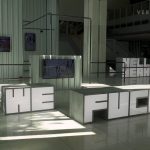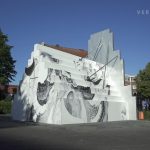Germany is participating in the 56th International Art Exhibition – La Biennale di Venezia with a group show called Fabrik. The exhibition in the German pavilion features works by the artists Olaf Nicolai, Hito Steyerl, Tobias Zielony, and Jasmina Metwaly / Philip Rizk. This video provides you with an exhibition walk-through, and interview with Tobias Zielony is coming soon.
Fabrik. Olaf Nicolai, Hito Steyerl, Tobias Zielony, and Jasmina Metwaly / Philip Rizk at German Pavilion at Venice Art Biennale 2015. Preview, May 7, 2015.
> Right-click (Mac: ctrl-click) this link to download Quicktime video file.
Florian Ebener, Head of the Photographic Collection, Museum Folkwang, Essen, and Curator of the German Pavilion 2015:
The German Pavilion has often acted as an artistic echo chamber for German history and identity. This year, the Pavilion’s large, quiet interior with its great height and accompanying sense of volume is a resonant space in which the productive sound of a globalized world can be heard. Starting from their varied reflections on the notions of ‘work’, ‘migration’, and ‘revolt’, the four artistic positions transform the building into a factory, into a vanished, virtual factory of the imagination, into a factory for political narratives and for analysing our visual culture.
The actors who populate the works by Olaf Nicolai, Hito Steyerl, Tobias Zielony, and Jasmina Metwaly / Philip Rizk are figures of revolt. We are confronted by these figures in all four works—be they theatrical, photographic, filmic, virtual, and / or physical in nature. The interpretation of the building’s verticality provides a number of different stages for this pavilion with its inherent spirit of resistance: ranging from a basement area all the way up to the roof. It is important too that the roof appears as a heterotope, as ‘another place’, in which freedom is evoked.
Olaf Nicolai puts the roof on show as the setting for a seven-months-long action. His protagonists perform a mysterious activity, a shadow economy enacted under a glistening sun. The choreography of his figures shifts focus between functional actions (or the actual production of an object) and the aesthetic dimension of what is done.
Hito Steyerl’s video installation Factory of the Sun shows a world in turmoil and a world of images on the move. It involves the translation of real political figures into virtual figures and an innovative experience of making and engaging with images, somewhere between a documentary approach and full-on virtuality. The new ‘digital light’ is the main medium used to transfer what is left of reality into a circulating digital visual culture.
Tobias Zielony’s documentary essay consists of photographs that he took of African refugees in Berlin and Hamburg. On the one hand, they form an autonomous photographic narrative, on the other, they are the subjects of articles that African authors have published in newspapers in the protagonists’ countries of origin—in Sudan, Cameroon, and Nigeria.
The video installation by Jasmina Metwaly and Philip Rizk is an experimental chamber play in filmic form. For their film project Out on the Street, the artist duo invited Cairenes, both employed and unemployed, to an improvised studio on the roof of an apartment block, where they were encouraged to tell their own stories of relational power dynamics based on the premise of a factory that has been privatized and wound up.
If nothing else, the Pavilion can be read as a parable for the metamorphosis of visual media, from pictures as classical recordings to the generation, processing, and projection of images. It can also be seen as a statement about the changing use of images, which blurs the boundaries between document, testimony, and fiction.









